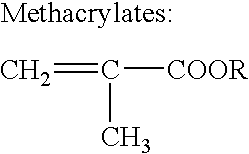Adhesives for metal bonding applications
a technology of adhesives and metals, applied in the direction of adhesive types, organic non-macromolecular adhesives, inks, etc., can solve the problems of poor mixability, high viscosity, and inability to use the adhesive sid
- Summary
- Abstract
- Description
- Claims
- Application Information
AI Technical Summary
Benefits of technology
Problems solved by technology
Method used
Image
Examples
example 1
[0068] Table 2 provides an example composition of the activator part of the present adhesive formulations. In general, as mentioned, the activator part may include a sole initiator. On the other hand, the activator part may include a primary initiator and a co-initiator. Exemplary ranges of the mole ratio of the co-initiators (when employed) to the primary initiators are generally less than 0.5.
[0069] In Example 1, the activator part includes a sole initiator, BPO, which is in a paste form sold under the trade name LUPERCO ANS by Elf Atochem North America Inc. of Philadelphia, Pa. In this example, the carrier of the BPO may include plasticizers and surfactants. An exemplary plasticizer is diisodecyl adipate (DIDA). Furthermore, as indicated in Table 2, the activator part may include thickening agents. Examples of thickening agents are EPON® 828, Paraloid® BTA-753, and an activator premix having Kraton® 01652. The activator part may also include colorants, such as products VC10000M ...
example 2
[0070] In Example 2, the presence of EDTA Na4 Premix in the adhesive part improved the storage stability of the adhesive part. As a result, stringiness of the adhesive part is significantly reduced. Moreover, as indicated in Table 3, the EDTA Na4 Premix also improved the mechanical properties of the cured adhesives.
TABLE 3Effect of EDTA Na4 Premix on Stability of AdhesivePart and on Properties of Cured AdhesivesAdhesive Part, % by weightEx. 2.1Ex. 2.2Ex. 2.3Ex. 2.4IngredientMethyl methacrylate20.1919.6919.194.61Methacrylic acid5.005.005.005.005% EDTA Na4 Premixa1.001.502.000.94Neoprene AD10 Premixb50.0050.0050.0067.75PARALOID ® BTA 75318.0018.0018.0016.54P-2M2.002.002.002.00N,N-bis(2-hydroxyethyl)-p-toluidine0.700.700.700.70NQ Premixc0.060.060.060.06MOLY-WHITE ®0.650.650.650.65101 ED Plus PremixdIGI Paraffin wax 12300.750.750.750.75SR 7081.001.001.001.00StringinessAged at 110° F. for 4 daysslightlynonenoneverybetter thanstringyEx. 2.4Aged at 110° F. for 10 daysveryalmostalmostnotS...
example 3
[0071] The examples in Table 4 demonstrate that a relatively small amount of very low Tg elastomeric polymer can improve the low temperature performance without significant loss of high temperature performance (e.g., lap shear strength at high temperature). In this example, the mix ratio of the adhesive part to the activator part is 10:1 by volume. The results in Table 4 show that the impact strength at −40° C. (−40° F.) increased with only modest loss of lap shear strength at 82° C. (180° F.).
TABLE 4Effect of Very Low Tg Elastomeric Polymeron Performance of Cured AdhesiveAdhesive Part, % by weightIngredientEx. 3.1Ex. 3.2Methyl methacrylate19.6919.69Methacrylic acid5.005.005% EDTA Na4 Premix1.501.50Neoprene AD10 Premix50.0040.00Kraton ® D1116Premixa—10.00PARALOID ® BTA 75318.0018.00P-2M2.002.00N,N-bis(2-hydroxyethyl)-p-toluidine0.700.70NQ Premix0.060.06MOLY-WHITE ® 101 ED Plus Premix0.650.65IGI Paraffin wax 12300.750.75SR 7081.001.00PropertyEx. 3.1 / 1.1Ex. 3.2 / 1.1Tensile, psib34743...
PUM
| Property | Measurement | Unit |
|---|---|---|
| Temperature | aaaaa | aaaaa |
| Temperature | aaaaa | aaaaa |
| Temperature | aaaaa | aaaaa |
Abstract
Description
Claims
Application Information
 Login to View More
Login to View More - R&D
- Intellectual Property
- Life Sciences
- Materials
- Tech Scout
- Unparalleled Data Quality
- Higher Quality Content
- 60% Fewer Hallucinations
Browse by: Latest US Patents, China's latest patents, Technical Efficacy Thesaurus, Application Domain, Technology Topic, Popular Technical Reports.
© 2025 PatSnap. All rights reserved.Legal|Privacy policy|Modern Slavery Act Transparency Statement|Sitemap|About US| Contact US: help@patsnap.com

